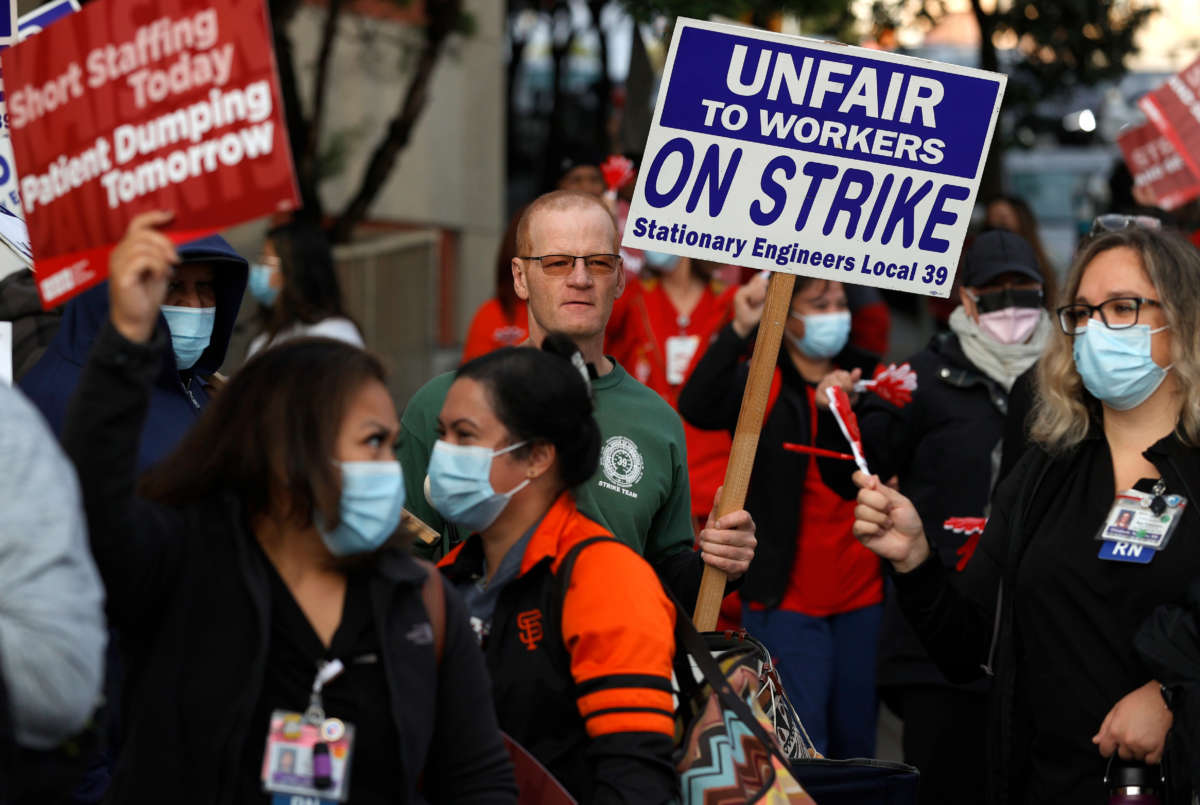Workers waged hundreds of work stoppages in 2021, marking millions of total “strike days” over the course of the year that saw a resurgence of the U.S. labor movement but a decline in overall union membership.
According to a new report by researchers at the School of Industrial and Labor Relations at Cornell University, 140,000 workers went on strike or otherwise participated in a work stoppage last year in 265 strikes and lockouts. Together, the workers logged over 3.2 million strike days.
Pay was the most common reason for workers to go on strike, the data shows. Nearly 60,000 workers in 160 work stoppages were demanding better pay. Demands for better benefits like health care and retirement were also significant, with over a million strike days logged for each.
The data lends credence to the idea that 2021 was a major year for the labor movement, which advocates deemed the “year of the worker.” The year saw a flurry of labor activity among unionized and nonunionized workers even as overall union membership continued to decline in 2021. Major strikes involved workers at Kellogg, John Deere and Kaiser Permanente and graduate students at Columbia University, to name a few.
The research also corroborates evidence that 2021 did indeed experience “Striketober” – where the months of October and November saw an increase in the number of work stoppages, relative to the rest of the year.
According to Eli Friedman, Cornell labor professor and report co-author, part of the motivation for conducting the research is to present more comprehensive data than that of the Bureau of Labor Statistics (BLS), which doesn’t record strikes involving fewer than 1,000 workers thanks to Ronald Reagan-era budget cuts. This means that the BLS data only records a small fraction of the total work stoppages. Though it has not yet put out a report for this year, the agency appears to have only logged 13 work stoppages in 2021 according to its monthly data.
Because this is the first year that researchers have put together more comprehensive data, there’s no baseline from recent years with which to compare last year’s data. Compared to the BLS data analysis report from the late 1970s, however, 2021’s work stoppages are only a fraction of what they used to be; in 1979, BLS recorded nearly 5,000 work stoppages, with the median stoppage lasting about a month.
The labor movement appears to be on the rise again after many years of relative dormancy, however, and Friedman says that strikes in 2021 may have been inspired by the labor movement in 2018 and 2019, which saw an increase in strikes. Those strikes may have “captured the imagination” of the labor movement, Friedman told Truthout.
According to the research, the fact that nearly a third of work stoppages were waged by nonunion workers last year could be a sign that workers are ready for unrest. As last year’s so-called great resignation demonstrated, many labor protests are individualized, but “more collective forms of response are still in the arsenal,” Friedman said.
Major union campaigns are also evidence that the labor movement is growing stronger, with Bessemer, Alabama, Amazon workers’ campaign making waves last year and Starbucks workers’ union drive growing larger and larger nearly every day.
Without institutional action like passing the Protecting the Right to Organize Act (PRO Act) or other mass forms of action, however, there is little chance that the labor movement can break through and start to rebuild to levels seen in the 20th century.
“The Democratic Party, despite moving to the left in some ways, is not making laborers or a reform of labor institutions a priority,” Friedman said. “And so there’s a question: ‘At what point does this bottom-up pressure of work unrest create enough pressure on the political system to create some kind of legal and institutional reforms?’, which I think pretty much everyone recognizes will be necessary to reverse the decline in unionization.”
We have 9 days to raise $50,000 — we’re counting on your support!
For those who care about justice, liberation and even the very survival of our species, we must remember our power to take action.
We won’t pretend it’s the only thing you can or should do, but one small step is to pitch in to support Truthout — as one of the last remaining truly independent, nonprofit, reader-funded news platforms, your gift will help keep the facts flowing freely.
